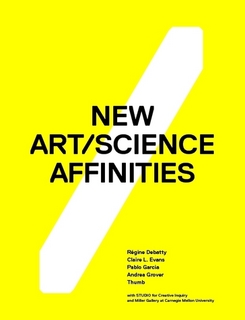Grover, Debatty, Evans, Garcia, Thumb: New Art/Science Affinites (2011)
Filed under sprint book | Tags: · art, bio art, biotechnology, hacking, maker culture, media art, programming, science, subversion, technology

The Miller Gallery at Carnegie Mellon University and the STUDIO for Creative Inquiry have co-published “New Art/Science Affinities,” a 190-page book on contemporary artists that was written and designed in one week by four authors (Andrea Grover, Régine Debatty, Claire Evans and Pablo Garcia) and two designers (Luke Bulman and Jessica Young of Thumb).
“New Art/Science Affinities,” which focuses on artists working at the intersection of art, science and technology, was produced by a collaborative authoring process known as a “book sprint.” Derived from “code sprinting,” a method in which software developers gather in a single room to work intensely on an open source project for a certain period of time, the term book sprint describes the quick, collective writing of a topical book.
The book includes meditations, interviews, diagrams, letters and manifestos on maker culture, hacking, artist research, distributed creativity, and technological and speculative design. Chapters include Program Art or Be Programmed, Subvert! Citizen Science, Artists in White Coats and Latex Gloves, The Maker Moment and The Overview Effect.
Sixty international artists and art collaboratives are featured, including Agnes Meyer-Brandis, Atelier Van Lieshout, Brandon Ballengée, Free Art and Technology (F.A.T.), Rafael Lozano-Hemmer, The Institute for Figuring, Aaron Koblin, Machine Project, Openframeworks, C.E.B. Reas, Philip Ross, Tomás Saraceno, SymbioticA, Jer Thorp, and Marius Watz.
The authors collectively wrote and designed the book during seven, 10-14 hour-days in February 2011 at the STUDIO for Creative Inquiry. During their sessions they held conversations with CMU faculty, staff and students from the STUDIO, Miller Gallery, College of Fine Arts, Robotics Institute, Machine Learning Department and BXA Intercollege Degree Program.
“The book sprint method was adopted in order to understand this very moment in art, science and technology hybrid practices, and to mirror the ways Internet culture and networked communication have accelerated creative collaborations, expanded methodologies, and given artists greater agency to work fluidly across disciplines,” says lead author Andrea Grover.
The publication is part of Grover’s Andy Warhol Foundation for the Visual Arts Curatorial Research Fellowship at CMU’s STUDIO for Creative Inquiry and Miller Gallery. “Intimate Science,” an exhibition that will be the product of Grover’s research, will take place in early 2012 at the Miller Gallery.
Published by Miller Gallery at Carnegie Mellon University + CMU STUDIO for Creative Inquiry, October 2011
ISBN 0977205347
190 pages
Licensed under Creative Commons Attribution-NonCommercial-NoDerivs 3.0 License
commentary (We-Make-Money-Not-Art.com)
authors
Collaborative Futures, 2nd ed. (2010)
Filed under sprint book | Tags: · collaboration, crowdfunding, education, mass collaboration, participation

Despite these words, the true nature of collaborative culture as a form of creative expression in the context of digital and network technologies has remained elusive, a buzzword often falling prey to corporate and ideological interests. This book was first created by 6 core collaborators, as an experimental five day Book Sprint in January 2010. Developed under the aegis of transmediale.10, this third publication in the festival’s parcours series resulted in the initiation of a new vocabulary on the forms, media and goals of collaborative practice.
In June 2010, the book was rewritten as a part of the Re:Group exhibition at Eyebeam, NY. This second edition invited three new collaborators to challenge the free culture sentiment underlying the original writing. The result is a deliberately multi-voiced tone pondering the merits and shortcomings of this new emerging ideology.
Core writers: Adam Hyde, kanarinka, Mike Linksvayer, Michael Mandiberg, Marta Peirano, Sissu Tarka, Astra Taylor, Alan Toner, Mushon Zer-Aviv.
ISBN: 9780984475018
Licensed under a Creative Commons Attribution-ShareAlike 3.0 Unported License.
Collaborative Futures (2010)
Filed under sprint book | Tags: · collaboration, crowdfunding, education, mass collaboration, participation
This book was written in a collaborative Book Sprint by six core authors over a five-day period in January 2010. It was developed under the aegis of transmediale, and executed by FLOSS Manuals. The six starting authors each come from different perspectives, as are the contributors who were adding to this living body of text.
“As we began the collaborative process of crafting this book on the future of collaboration, we realized we were all working from a set of assumptions, many of them shared, some of them divergent. We were talking about a specific form of collaboration, specific media of collaboration, and specific goals of collaboration. And we were talking about a specific history of collaboration, and a correspondingly specific set of futures.
To begin looking at those futures, we look back to others who have looked into the future. Marshall McLuhan’s quote above, from “The Medium is the MESSAGE” give us our first clue about all of these assumptions we are making. We are talking about media, we are talking about freedom, we are talking about technologies, and we are talking about culture. McLuhan’s prophetic utterance, several decades before the photocopier fueled the punk cut-up design aesthetic, or the profusion of home-brew zines, is still a prophecy unmet. We are still chasing it. Mainstream culture continues to consolidate around block buster films, books, and music. Copyright restrictions make it harder and harder to exercise the creative power of these reproduction tools without breaking increasingly restrictive intellectual property rights laws. But one thing is unanimously true: “Teamwork succeeds private effort.” ”
© Collaborative Futures Book Sprint team 2010
Written and produced by Mushon Zer-Aviv, Mike Linksvayer, Michael Mandiberg, Marta Peirano, Alan Toner and Adam Hyde with a number of special guest writers
Produced by FLOSS Manuals and Transmediale
To be published by Transmediale
Series: parcours #3
PDF (PDF)
View online (by chapter; HTML)
View online (full; HTML)

